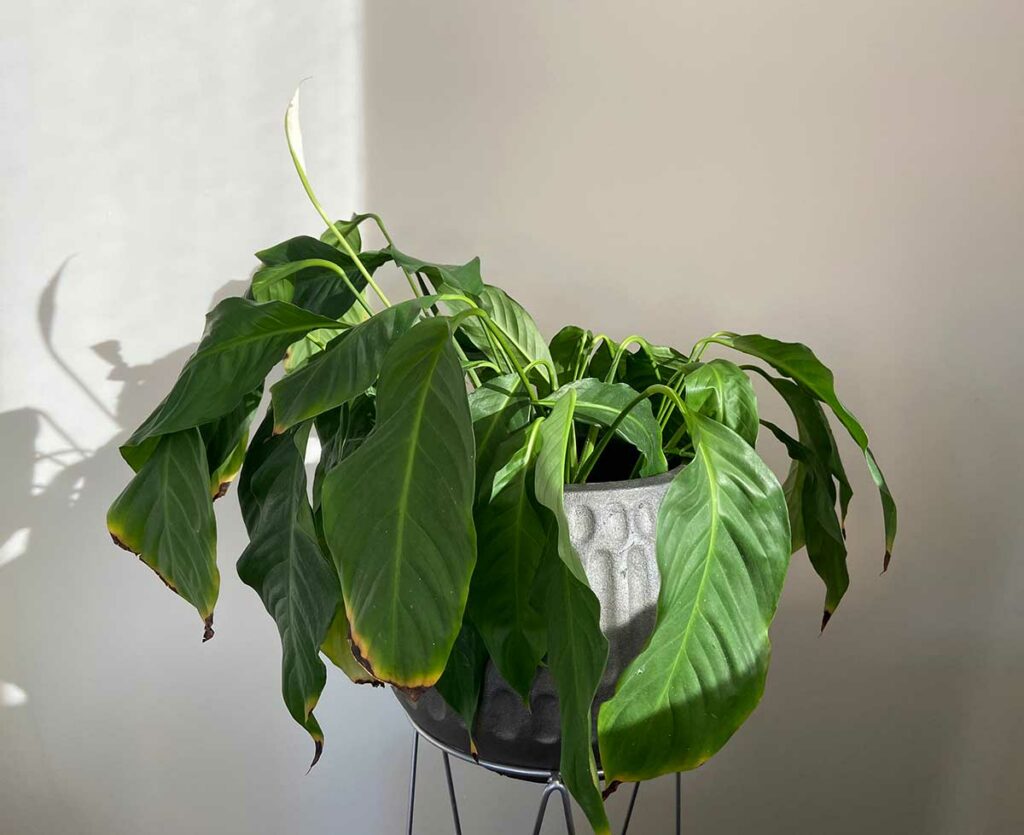
Like other living things, peace lilies have a particular set of needs. If those needs aren’t met, they won’t remain living for long.
Fortunately, peace lilies are resilient plants, making it possible to turn things around for them even when it looks like all hope is lost.
It’s all about correctly diagnosing common problems and taking action before your peace lily’s viability is pushed past the breaking point. This article will take a look at some of those problems and offer advice for rectifying them before it’s too late.
The Problem: Drooping Foliage
Are your peace lily’s flowers and leaves sagging like they just received bad news? What’s going on?
Peace lilies are tropical plants that thrive in humid conditions. The plants are happiest when securely nestled in moist (yet well-drained) soil.
A simple way to test whether your peace lily’s soil is wet enough is to stick your finger in the pot up to about your second knuckle. Does it feel dry? If so, it’s time to give your peace lily something to drink.
The Solution: More Frequent Waterings
Get in the habit of watering your peace lily at least once per week if you’re not doing so already. You may need to increase the frequency of your waterings if you live in an area with low average humidity or run your air conditioner constantly.
Whenever you water your plant, keep pouring the water until you start to see the runoff coming out the bottom of the container. That way, you can be sure that the soil is thoroughly saturated.

The Problem: Brown Spots or Streaks
Are brownish lesions crisscrossing your peace lily’s once-flawless leaves? Why is this happening?
The dark discoloration is usually a symptom of sunburn. In their natural habitat, peace lilies are found in the shady upper canopy of tropical forests. In other words, they’re not used to soaking up intense, direct sunlight.
The Solution: Give it Some Shade
The reason you’re encountering this issue is you’ve recently moved your peace lily from a shady spot to an area that receives full sunlight. The best thing you can do is move it back to the shady space. Peace lilies do best in places with partial sun, such as a screened-in porch or a shelf in the interior part of the room.
Resist the urge to cut your plant back for now. Instead, watch it closely and make sure you’re keeping up with your regular waterings. The peace lily should improve in time.
Once your peace lily has sprouted some healthy new leaves, feel free to trim the affected foliage.
The Problem: Yellowing Leaves
Has your peace lily gone from a vibrant green to an awkward unripe-banana yellow, giving it a sickly appearance? Something’s got to give.
When a peace lily begins turning yellow, it means one of two things: over-watering or lack of essential nutrients. The easiest way to determine which one is to go by your plant’s age.
The Solution: Check Your Drainage or Fertilize as Needed
Younger plants tend to yellow due to overwatering. Perform a quick soil test by plunging your finger in a couple of inches. If the soil feels swampy, you’re most likely dealing with inadequate drainage.
Repot your peace lily in a container with a bigger drainage hole (or multiple holes). You can also modify a container you’re partial to by drilling new holes or increasing the size of the existing opening. The next time you water the plant, less liquid is left behind.
If your peace lily is a little older, it could be suffering from a nutrient deficiency. This occurs when the roots have exhausted the available nutrients in the surrounding soil.
That may sound dire, but it’s nothing a spritz of liquid fertilizer won’t fix. A general rule of thumb is to fertilize your peace lily once every six weeks.
Conclusion
As houseplants go, peace lilies are a low-maintenance, easygoing species that demand very little effort or involvement, provided you’re attuned to their needs. Hopefully, you now have a better idea of what those are and how to meet those needs. Your reward will be the appearance of a magnificent snow-white flower stalk come spring.








